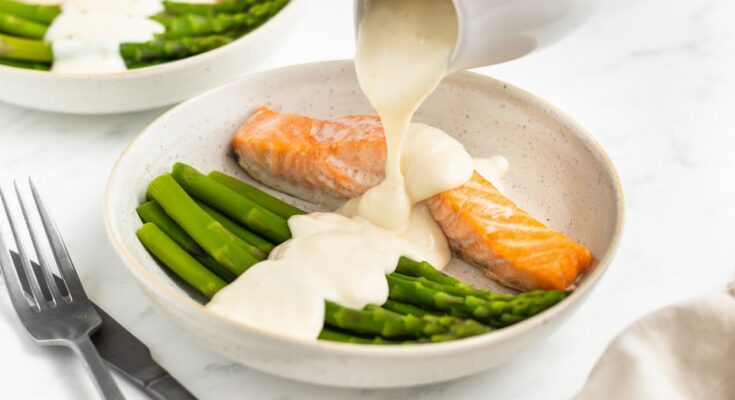Mornay Sauce Recipe: There’s something timeless about creamy, velvety sauces that instantly elevate any dish — and Mornay sauce is one of those luxurious classics. Whether you drizzle it over vegetables, pour it onto pasta, or use it to top baked fish, this sauce turns a simple meal into something spectacular. In this guide, you’ll learn exactly how to make Mornay sauce from scratch — no fancy culinary degree required.
What is Mornay Sauce?
Mornay sauce is a rich, cheesy version of the traditional Béchamel sauce, which is one of the five “mother sauces” in French cuisine. Essentially, it’s a white sauce thickened with butter and flour (a roux), enriched with milk, and finished with a generous amount of cheese — most commonly Gruyère, Parmesan, or Cheddar.
It’s creamy, savory, and slightly nutty, making it a perfect base for countless dishes, from macaroni and cheese to croque monsieur. The beauty of this sauce lies in its versatility; it pairs beautifully with proteins, vegetables, and even eggs.
History and Origin of Mornay Sauce
Mornay sauce has its roots in 17th-century France, where culinary sophistication was at its peak. The sauce is named after either Philippe or Charles de Mornay, noblemen associated with elegant Parisian dining. Initially, it was served with fish and vegetables in the lavish courts of French aristocracy. Over time, chefs began adapting it to modern dishes, making it a staple in French-inspired kitchens worldwide.
Today, Mornay sauce has found its way into many global cuisines. Whether you’re layering it in lasagna, pouring it over cauliflower, or adding it to seafood, this sauce adds a professional touch to everyday cooking.
Why You’ll Love This Recipe
There’s more to love about this sauce than just its taste. It’s:
- Simple to make: Only a few ingredients are needed, and you can whip it up in under 20 minutes.
- Rich and creamy: The cheese gives it an irresistible smooth texture.
- Versatile: Works beautifully in pasta, casseroles, eggs, and more.
- Customizable: Use your favorite cheeses or seasonings to make it your own.
Ingredients You’ll Need
Basic Ingredients for Mornay Sauce
To make the perfect Mornay sauce, gather the following ingredients:
| Ingredient | Quantity | Purpose |
|---|---|---|
| Unsalted butter | 2 tbsp | Forms the base of the roux |
| All-purpose flour | 2 tbsp | Thickens the sauce |
| Whole milk | 2 cups | Adds creaminess |
| Gruyère cheese (grated) | ½ cup | Gives a nutty, rich flavor |
| Parmesan cheese (grated) | ¼ cup | Adds sharpness |
| Salt | To taste | Enhances overall flavor |
| Ground white pepper | ¼ tsp | Adds subtle spice |
| Nutmeg (optional) | A pinch | Adds warmth and depth |
These are your building blocks. The key is balance — the roux must be cooked just right, and the cheese should melt smoothly without clumping.
Choosing the Right Cheese for Mornay Sauce
Traditionally, Mornay sauce uses Gruyère or Emmental cheese because they melt beautifully and lend a slightly nutty flavor. However, modern versions often incorporate Cheddar, Monterey Jack, or Parmesan for variety.
If you want a luxurious twist, try a blend:
- ½ Gruyère + ¼ Parmesan for a classic French profile.
- ½ Cheddar + ¼ Mozzarella for a creamier, milder sauce.
- ½ Fontina + ¼ Asiago for an Italian-inspired flair.
Optional Add-ins for Extra Flavor
- A splash of dry white wine for acidity.
- A teaspoon of Dijon mustard for tang.
- Chopped herbs like parsley or chives for color and freshness.
Equipment You’ll Need
Kitchen Tools and Utensils
Before starting, make sure you have:
- A medium saucepan (preferably heavy-bottomed).
- A whisk (for a smooth, lump-free sauce).
- A wooden spoon or spatula.
- A grater (for freshly grated cheese).
- Measuring cups and spoons for accuracy.
Using the right tools can make or break your sauce — a whisk, for example, ensures even mixing so the roux and milk blend seamlessly.
Tips for Preparing Your Cooking Space
- Mise en place: Measure and prepare everything beforehand.
- Use room-temperature milk: It helps prevent clumping.
- Grate cheese freshly: Pre-shredded cheese contains anti-caking agents that prevent smooth melting.
- Low heat is your friend: Patience creates a smoother sauce.
Step-by-Step Guide to Making Mornay Sauce
Step 1 – Preparing the Roux
In a medium saucepan, melt 2 tablespoons of butter over low to medium heat. Once melted, sprinkle in 2 tablespoons of flour while whisking continuously. This forms your roux, the thickening base of the sauce.
Whisk for 1–2 minutes until the mixture becomes slightly golden and smells nutty — this means the raw flour taste is gone. Be careful not to brown it too much; Mornay sauce should stay creamy and pale.
Pro Tip: Keep whisking! If you stop, the roux may burn or clump.
Step 2 – Adding the Milk
Once the roux is ready, slowly pour in 2 cups of warm milk, whisking constantly to avoid lumps. Start with a small amount first to loosen the roux, then gradually add the rest.
Continue whisking for 5–7 minutes until the sauce thickens enough to coat the back of a spoon. This is your Béchamel base, and it’s the foundation of a perfect Mornay sauce.
Step 3 – Melting in the Cheese
Remove the saucepan from heat, then add ½ cup of grated Gruyère and ¼ cup of Parmesan gradually, stirring until melted. The key is to add the cheese in portions to prevent it from curdling.
Once smooth and creamy, season with a pinch of salt, white pepper, and nutmeg if desired.
At this stage, you’ve officially transformed a Béchamel into a Mornay sauce — silky, cheesy, and ready to serve.
Step 4 – Seasoning and Adjusting Consistency
Taste and adjust your sauce. If it’s too thick, whisk in a bit of warm milk. If it’s too thin, let it simmer gently until it thickens.
Your goal is a smooth, pourable consistency — not runny, not stiff.
Tips for Perfect Mornay Sauce Every Time
Avoiding Lumps
Always whisk continuously when adding milk to the roux. A gradual pour and steady motion ensure a velvety texture. If lumps do appear, use an immersion blender to fix it quickly.
Preventing the Sauce from Splitting
Never boil your sauce after adding cheese — high heat can cause it to separate. Keep it on low heat and stir gently until everything is melted.
Adjusting the Thickness
Want a thicker sauce? Simmer a few extra minutes. Need it thinner? Add a splash of warm milk or cream.
How to Use Mornay Sauce
Classic Dishes Featuring Mornay Sauce
Mornay sauce is a culinary chameleon — it fits beautifully into so many dishes that it’s almost impossible not to find a use for it. Traditionally, it’s the go-to sauce for croque monsieur, the famous French toasted ham and cheese sandwich. The sauce adds a rich, velvety layer that transforms an ordinary sandwich into a Parisian bistro favorite.
Another classic is macaroni au gratin, or what many of us simply call mac and cheese. Mornay sauce gives it that unmistakable creaminess and golden top when baked. It’s also commonly used in seafood gratins, eggs Florentine, or vegetable casseroles — essentially, any dish that benefits from a smooth, cheesy blanket of flavor.
Here are some traditional dishes where Mornay sauce shines:
- Croque Monsieur or Croque Madame
- Macaroni Gratin
- Cauliflower or Broccoli au Gratin
- Baked Lobster or Fish
- Eggs Florentine
- Lasagna with Cheese Sauce Layers
Creative Ways to Enjoy It
Beyond the classics, you can get creative. Use Mornay sauce as:
- A pasta sauce: Mix it with fettuccine or penne for an instant gourmet meal.
- A dip: Serve it warm with crusty bread, pretzels, or vegetable sticks.
- A base for soups: Add broth to thin it slightly and create a cheesy, creamy soup.
- A pizza topping: Replace tomato sauce with Mornay for a white pizza twist.
When you think of Mornay sauce, imagine it as the French cousin of Alfredo sauce — only a bit more refined, with a nutty, elegant flavor.
Common Mistakes to Avoid
Overheating the Sauce
The most common mistake when making Mornay sauce is overheating. Cheese is delicate — when exposed to high heat, it can separate into fat and solids, leaving your sauce grainy instead of smooth. Always melt cheese over low heat and remove the pan from the stove as soon as it’s melted.
If you accidentally overheat it, try whisking in a little warm milk or cream to bring it back together. It won’t be perfect, but it can help salvage the sauce.
Choosing the Wrong Cheese
Not all cheeses melt equally well. Avoid using cheeses that are too oily or hard to melt, such as aged cheddar or blue cheese, unless blended with a smoother cheese. Stick with Gruyère, Fontina, Monterey Jack, or mild Cheddar for best results.
Also, avoid pre-shredded cheese — it contains anti-caking agents that can prevent smooth melting and affect texture. Freshly grated cheese always gives a silkier finish.
Skipping the Roux Cooking Step
Another common error is not cooking the roux long enough. If the flour remains raw, it gives your sauce a chalky taste. You want a slightly golden roux that smells nutty but not toasted — this ensures a clean, rich flavor.
Storage and Reheating Tips
Refrigeration Guidelines
Mornay sauce can be made ahead of time and stored for later use. Once cooled, transfer it to an airtight container and refrigerate for up to 3 days. To prevent a skin from forming on top, place a piece of plastic wrap directly on the surface of the sauce before sealing the container.
When reheating, always use low heat and stir frequently. If the sauce thickens too much, whisk in a splash of milk or cream until it returns to its silky consistency.
Freezing Mornay Sauce
While Mornay sauce can be frozen, it’s best enjoyed fresh. Dairy-based sauces can sometimes separate after thawing. However, if you do want to freeze it:
- Let the sauce cool completely.
- Pour it into a freezer-safe container, leaving space for expansion.
- Freeze for up to 2 months.
To reheat, thaw it overnight in the refrigerator, then warm gently on the stove while whisking constantly. A dash of milk can help smooth it out if it separates slightly.
Variations of Mornay Sauce
Gluten-Free Mornay Sauce
If you’re avoiding gluten, replace all-purpose flour with rice flour or cornstarch for the roux. Use a 1:1 ratio — 2 tablespoons of gluten-free flour for 2 tablespoons of butter. The process remains exactly the same, and you’ll end up with a velvety, gluten-free version that tastes just as luxurious.
Vegan Mornay Sauce Alternatives
For a vegan twist, skip the dairy but keep the creamy comfort. Substitute:
- Vegan butter or olive oil for regular butter.
- Unsweetened plant-based milk (like oat, soy, or cashew) for cow’s milk.
- Nutritional yeast or vegan cheese for the cheesy component.
Simmer the mixture until it thickens, then adjust with a pinch of salt, mustard, and lemon juice to balance the flavor. You’ll be surprised how close it tastes to the classic French version.
Nutritional Information
Here’s an approximate nutritional breakdown per serving (about ¼ cup):
| Nutrient | Amount |
|---|---|
| Calories | 160 kcal |
| Fat | 12g |
| Saturated Fat | 7g |
| Carbohydrates | 6g |
| Protein | 7g |
| Sodium | 190mg |
| Calcium | 220mg |
Keep in mind these values may vary depending on the type of cheese and milk used. For a lighter version, use low-fat milk and reduce the butter slightly.
FAQs about Mornay Sauce Recipe
1. What’s the difference between Béchamel and Mornay sauce?
Béchamel is a basic white sauce made with butter, flour, and milk. When you add cheese — typically Gruyère or Parmesan — it becomes Mornay sauce. Essentially, Mornay is a cheesy Béchamel.
2. Can I use pre-shredded cheese?
It’s best not to. Pre-shredded cheese contains anti-caking agents that prevent smooth melting, which can lead to a grainy sauce. Always grate cheese fresh for the creamiest texture.
3. How long does Mornay sauce last?
It keeps for about 3 days in the refrigerator. Store it in an airtight container with plastic wrap pressed on the surface to prevent a skin from forming.
4. Can I make Mornay sauce ahead of time?
Yes! You can make it a day ahead and reheat gently on low heat before serving. If it thickens too much, whisk in a splash of milk to loosen it.
5. What cheeses blend best for Mornay?
Gruyère and Parmesan are traditional, but you can mix in Fontina, Cheddar, or even Mozzarella for a different flavor profile.
Conclusion
Mornay sauce is more than just a cheesy topping — it’s a cornerstone of classic French cuisine that brings depth and richness to any meal. From humble pasta dishes to elegant seafood gratins, it adds a touch of sophistication that’s hard to beat.
Now that you know how to prepare it from scratch, you’ll never need to rely on store-bought cheese sauces again. Once you’ve mastered the base recipe, you can customize it endlessly with different cheeses, herbs, or even a hint of spice.
So next time you want to impress at dinner, whip up a batch of homemade Mornay sauce. It’s quick, easy, and guaranteed to make any dish taste like it came straight from a French kitchen.



